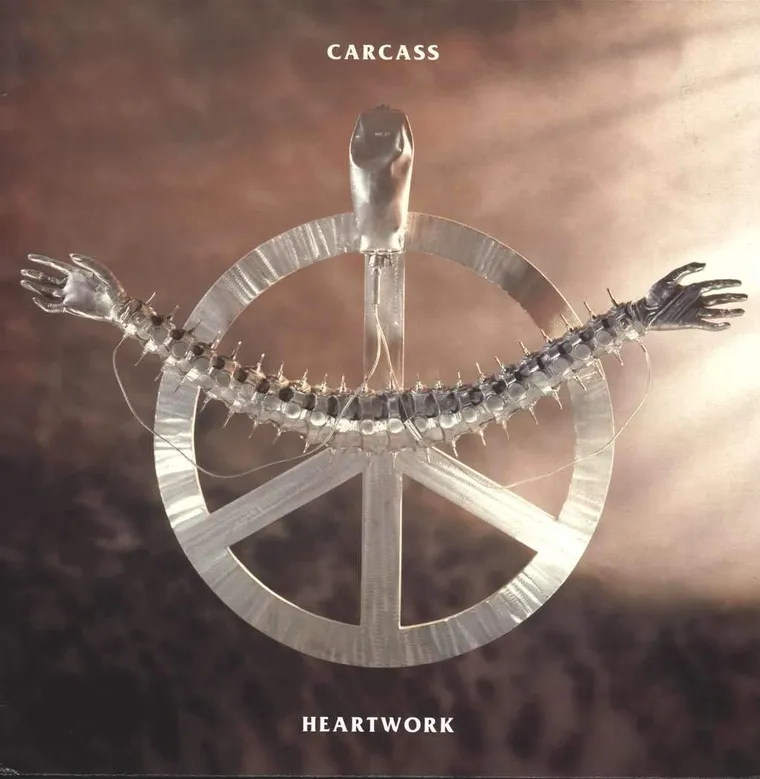Released on October 18, 1993, Carcass’s Heartwork didn’t just tweak their formula — it reimagined what death metal could be. This wasn’t a compromise. It wasn’t a sellout. It was a cold, calculated reinvention that fused melody with muscle, and carved a new path with a surgeon’s precision.
At a time when death metal was trying to go faster, harder, and uglier, Carcass pivoted. They didn’t tone things down — they just trimmed the fat. The gore was still there, the fury still intact. But now, it was focused. Streamlined. Artful.
If their early albums were chaotic morgue reports shouted over blast beats, Heartwork was something else entirely — a clean incision.
From Goregrind to Groove: A Band Transformed
Carcass had always thrived in extremes. Their debut was noisy, grimy, borderline unlistenable to anyone outside of tape-trading circles. But that was the point — it was raw, underground, and vile. By the time Necroticism dropped, the band had leveled up technically and creatively, but they were still buried under layers of medical jargon and fuzzy production.
Heartwork changed that.
This was the sound of a band growing up — not maturing in the lame, radio-friendly way, but refining their tools. They ditched the overstuffed titles, cleaned up the songwriting, and swapped suffocating grind for breathing room. The result was a record that sounded alive — still brutal, still intense, but infinitely more listenable.
Not because they went soft, but because they got smarter.
Hooks and Harmonics: What Heartwork Sounds Like
The album opens with “Buried Dreams,” and right away, you know something’s different. There’s a melodic intro — clean, haunting — followed by a mid-tempo riff that grooves instead of grinds. Jeff Walker’s trademark snarl is still there, but this time it’s riding a rhythm, not drowning in chaos.
From there, it’s riff after riff, each one tighter than the last. “Carnal Forge” hits harder and faster but still has that newfound clarity. The solos aren’t just fast — they sing. Bill Steer and Michael Amott deliver guitar work that feels purposeful, not showy.
Then you get to the title track — “Heartwork” — and everything clicks. It’s heavy. It’s memorable. It’s got that weird metallic beauty that almost no one else could pull off at the time. The chorus riff is iconic, and the solo section is pure melodic gold layered over pounding double-kick.
“This Mortal Coil” slows things down and leans into atmosphere. The riffs are more measured, the spaces wider, the mood darker. It’s not just aggressive — it’s elegant. And that word rarely applied to death metal in the early ’90s.
“Arbeit Macht Fleisch” is a standout for sheer songwriting complexity. It’s one of the few songs on the album that hints back at their earlier chaotic style, but even here the band sounds more in control — like chaos is being conducted, not unleashed.
Even toward the back end of the album, Carcass doesn’t let up. “Blind Bleeding the Blind” and “Death Certificate” show the same attention to detail, with dynamic shifts, layered melodies, and grooves that lodge in your spine. The album ends not with a bang, but with a slow, deliberate crush.
Brutality Refined: Emotion Beneath the Riffs
One of the most striking things about Heartwork is how emotional it feels — even though it’s not sentimental in any obvious way. There’s no clean singing, no ballads, no “metal for the masses” choruses. And yet, under the snarling vocals and surgical riffing, there’s a weird kind of beauty.
The melodies aren’t just technical exercises — they feel like statements. There’s anger, of course. But there’s also melancholy. A sense of something decaying not just physically, but emotionally. And that mood carries through the whole album.
It’s not gore-for-gore’s-sake anymore. The lyrics, while still cryptic and cynical, touch more on philosophical and societal themes than dissecting corpses. There’s still venom, but it’s aimed at the world — not just the flesh.
The Production: Cold, Clean, and Perfectly Fitted
The production on Heartwork is one of the reasons it still sounds so good today. It’s not flashy, but it’s right. The guitars are thick and heavy without being muddy. The drums are crisp. The vocals sit perfectly in the mix. Nothing feels buried or lost.
That was a bold move for a band coming out of the grindcore world. In an era when many extreme bands prided themselves on sounding like they recorded in a cave, Carcass went the other way — they made an album that sounded as precise as the music itself.
The result is a record that’s aged better than almost anything else from that scene and era.
The Legacy: Melodic Death Metal’s Foundation
Let’s be blunt — without Heartwork, there’s no melodic death metal as we know it. Sure, bands like At the Gates and In Flames would take the torch and run with it, but Carcass laid the groundwork. Not just in terms of style, but in mindset: that you could be brutal and melodic. That death metal could have structure, pacing, and yes — even grace.
At the time, some fans felt betrayed. “Carcass sold out,” they said. But over the years, Heartwork has become the go-to Carcass record for a reason. It bridges the gap between underground credibility and musical maturity. It’s not trying to please everyone. It just works.
Final Verdict: 9/ 10
Heartwork isn’t just a classic — it’s a blueprint. A turning point in metal where extremity met execution, where anger found melody, and where one of the gnarliest bands of the ’80s proved they could grow without compromising who they were.
It’s not as savage as Reek or Necroticism, and it doesn’t try to be. But that’s what makes it so powerful. It’s tight, focused, and dripping with intent.

